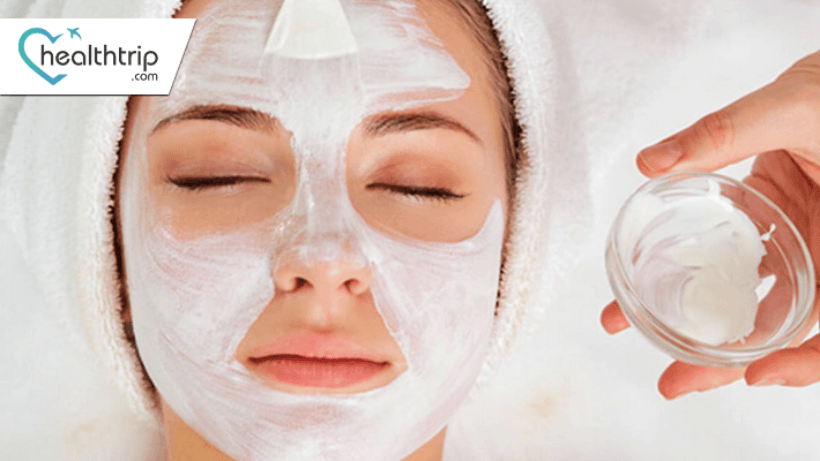
The Different Types of Chemical Peels: How to Choose the Right One for You
16 Nov, 2023
 Healthtrip Team
Healthtrip TeamChemical peels are a popular cosmetic treatment used to rejuvenate the skin, improve its texture, and address various skin concerns. They work by applying a chemical solution to the skin's surface, which exfoliates the outermost layer, leading to smoother, brighter, and more youthful-looking skin. However, not all chemical peels are the same, and choosing the right one for your skin type and concerns is essential. In this blog, we will explore the different types of chemical peels available and help you determine which one might be the best fit for your skincare needs.
1. Superficial Chemical Peels:
Most popular procedures in India
Superficial chemical peels are a popular choice among individuals looking to enhance the appearance of their skin with minimal downtime. These peels are often referred to as "lunchtime peels" because they are quick and convenient, allowing patients to resume their daily activities shortly after treatment. Here's a comprehensive breakdown of the key characteristics and benefits of superficial chemical peels:
Wellness Treatments
Give yourself the time to relax
Lowest Prices Guaranteed!

Lowest Prices Guaranteed!
1. Targeted Layer:
- Superficial chemical peels primarily target the outermost layer of the skin, known as the epidermis. The epidermis is composed of several sub-layers, and superficial peels work to exfoliate the topmost sub-layers.
- The exfoliation process helps remove dead skin cells, debris, and impurities from the surface of the skin, revealing a fresher, smoother, and more radiant complexion underneath.
2. Suitable Concerns:
- Fine Lines: Superficial peels can help reduce the appearance of fine lines and superficial wrinkles, particularly those caused by sun damage and aging.
- Uneven Skin Tone: They are effective in addressing uneven pigmentation, such as sunspots, age spots, and minor discoloration.
- Light Sun Damage: Superficial peels can help improve the effects of sun damage, such as photodamage and mild sunburn.
- Minor Blemishes: They can also aid in the treatment of minor acne blemishes and blackheads.
3. Active Ingredients:
- The active ingredients in superficial peels typically consist of alpha hydroxy acids (AHAs) or beta hydroxy acids (BHAs). These acids play a key role in the exfoliation process and offer various benefits for the skin.
- Common AHAs used in superficial peels include:
- Glycolic Acid: Glycolic acid is known for its ability to penetrate the skin effectively, promoting exfoliation and improving skin texture.
- Lactic Acid: Lactic acid provides gentle exfoliation and is suitable for individuals with sensitive skin.
- Salicylic Acid is a common BHA used in superficial peels. It is particularly effective for individuals with acne-prone or oily skin, as it can penetrate oil-filled pores, exfoliating from within.
4. Downtime:
- One of the significant advantages of superficial chemical peels is the minimal downtime they require. Patients can often return to their regular activities immediately after treatment.
- While some redness and mild peeling may occur, these side effects are typically mild and short-lived. Makeup can often be applied soon after the peel to conceal any redness.
5. Results:
- Patients undergoing superficial chemical peels may notice an immediate improvement in the texture and appearance of their skin.
- However, a series of treatments may be recommended to achieve optimal results, depending on the individual's specific concerns.
- Over time, patients can expect:
- Smoother Skin: The removal of dead skin cells and debris results in a smoother skin texture.
- Brighter Complexion: Superficial peels can help reveal a brighter and more radiant complexion.
- Improved Skin Tone: Uneven pigmentation and minor blemishes are gradually reduced, leading to a more even skin tone.
Superficial chemical peels are a gentle yet effective skincare treatment that can address mild skin imperfections. They offer a convenient option for individuals seeking to rejuvenate their skin without significant downtime. Whether you're concerned about fine lines, uneven skin tone, or light sun damage, superficial chemical peels can help you achieve smoother, brighter, and more youthful-looking skin with consistent treatments. It's advisable to consult with a skincare professional to determine if this type of peel is suitable for your specific needs and to create a personalized treatment plan.
2. Medium Chemical Peels:
Medium chemical peels are a step up in intensity from superficial peels and are well-suited for individuals with moderate skin concerns. These peels provide a deeper level of exfoliation and can effectively address a range of issues. Here's a closer look at the key aspects and benefits of medium chemical peels:
1. Targeted Layers:
- Medium chemical peels penetrate deeper into the skin compared to superficial peels. They target not only the epidermis (outermost layer) but also the upper part of the dermis (the deeper layer of the skin).
- This deeper penetration allows medium peels to address more significant skin concerns by targeting issues that originate in the dermis.
2. Suitable Concerns:
- Medium chemical peels are ideal for individuals with moderate skin imperfections and concerns. These may include:
- Moderate Sun Damage: Medium peels can effectively treat moderate sun damage, such as sunspots, freckles, and pigmentation irregularities.
- Age Spots: They are particularly effective at reducing the appearance of age spots (also known as liver spots or sunspots).
- Moderate Wrinkles: Medium peels can help improve the appearance of moderate wrinkles and fine lines, including those caused by aging and sun exposure.
- These peels are often recommended for individuals looking to rejuvenate their skin and achieve a more youthful appearance.
3. Active Ingredients:
- Trichloroacetic acid (TCA) is a common active ingredient used in medium chemical peels. TCA provides more significant exfoliation compared to the alpha hydroxy acids (AHAs) and beta hydroxy acids (BHAs) commonly found in superficial peels.
- TCA works by removing the top layers of skin, which triggers a natural healing response that results in the production of new, healthier skin cells.
4. Downtime:
- One of the notable differences between medium and superficial peels is the downtime required after treatment.
- Medium chemical peels typically necessitate several days of downtime. During this period, patients may experience redness, swelling, and peeling of the skin.
- It is crucial to follow post-treatment instructions provided by your skincare professional, including sun protection, to ensure proper healing and minimize potential complications.
5. Results:
- Patients undergoing medium chemical peels can expect noticeable improvements in their skin's appearance and texture.
- While some immediate results may be visible, the full benefits become more apparent as the skin heals and regenerates.
- Over time, patients can achieve:
- Improved Skin Tone: Reduction in the appearance of pigmentation irregularities and age spots, leading to a more even skin tone.
- Enhanced Texture: Smoother and more refined skin texture, with reduced roughness and fine lines.
- Reduction in Wrinkles: Moderate wrinkles and lines may become less prominent, contributing to a more youthful look.
6. Number of Sessions:
- Multiple sessions of medium chemical peels may be necessary to achieve the desired results, depending on the severity of the skin concerns and the individual's goals.
- Your skincare professional will assess your progress and recommend an appropriate treatment plan tailored to your needs.
Medium chemical peels provide a deeper level of exfoliation and are effective at addressing moderate skin concerns, including sun damage, age spots, and moderate wrinkles. While they require a longer recovery period compared to superficial peels, the noticeable improvements in skin tone and texture make them a valuable option for those seeking comprehensive skin rejuvenation. Consultation with a qualified skincare professional is essential to determine if medium chemical peels are suitable for your specific concerns and to create a personalized treatment plan that aligns with your goals.
3. Deep Chemical Peels:
Deep chemical peels are the most intensive and aggressive type of chemical peel, designed to address severe skin concerns and provide dramatic rejuvenation. These peels penetrate deeply into the skin, including the lower dermis, making them a powerful tool for addressing deep wrinkles, scars, and extensive sun damage. Here's a comprehensive overview of the key features and benefits of deep chemical peels:
1. Targeted Layers:
- Deep chemical peels reach the deepest layers of the skin, including the lower dermis. This level of penetration allows them to target and address issues that originate deep within the skin.
- By reaching the lower dermis, deep peels can stimulate significant collagen production, which is crucial for skin elasticity and firmness.
2. Suitable Concerns:
- Deep chemical peels are specifically reserved for individuals with severe skin issues and concerns. These may include:
- Deep Wrinkles: These peels are highly effective at reducing the appearance of deep wrinkles, such as those often associated with aging.
- Acne Scars: Deep chemical peels can help improve the texture and appearance of acne scars, including deep pitted scars.
- Extensive Sun Damage: They are ideal for individuals with extensive sun damage, including pronounced sunspots, age spots, and photodamage.
- Deep peels are recommended when less aggressive treatments have not provided satisfactory results.
3. Active Ingredients:
- The primary active ingredient used in deep chemical peels is phenol. Phenol is known for its potent exfoliating properties and ability to penetrate deep into the skin.
- Phenol works by breaking down and removing damaged skin cells and triggering a profound healing response within the skin.
4. Downtime:
- Recovery after a deep chemical peel can be substantial and lengthy compared to superficial and medium peels.
- Patients may experience significant peeling, redness, and swelling during the recovery period, which can last several weeks.
- It is crucial to follow strict post-treatment care instructions, including sun protection and moisturization, to ensure proper healing and minimize the risk of complications.
5. Results:
- Deep chemical peels provide some of the most dramatic improvements in skin texture and appearance.
- Patients can expect:
- Significant Reduction in Wrinkles: Deep peels can effectively diminish the appearance of deep wrinkles, resulting in a smoother and more youthful complexion.
- Improved Skin Texture: The exfoliation process and collagen stimulation contribute to improved skin texture and a more even tone.
- Scar Reduction: Acne scars and other types of scars may become less prominent with deep chemical peels.
- Long-Lasting Results: The results of deep chemical peels are long-lasting, and many individuals experience a profound transformation in their skin.
6. Post-Treatment Care:
- Careful post-treatment care is essential after a deep chemical peel. Sun protection is critical to prevent sun damage to the newly revealed skin.
- Patients are advised to follow their skincare professional's guidance on moisturization, cleansing, and avoiding certain skincare products during the recovery period.
Deep chemical peels are a potent solution for individuals with severe skin concerns, including deep wrinkles, acne scars, and extensive sun damage. While the recovery period is substantial, the dramatic and long-lasting results make them a valuable option for those seeking comprehensive skin rejuvenation. Consultation with a qualified skincare professional is imperative to determine if a deep chemical peel is suitable for your specific concerns and to create a personalized treatment plan that aligns with your goals.
5. Specific Ingredient Peels:
Apart from categorizing chemical peels by their depth, they can also be classified based on specific active ingredients tailored to address specific skin concerns. Here are some examples:
1. Salicylic Acid Peels:
- Active Ingredient: Salicylic acid
- Suitable Concerns: Salicylic acid peels are highly effective for individuals with acne-prone and oily skin. The key benefit of salicylic acid is its ability to penetrate deep into the pores, where it can effectively unclog them and reduce the occurrence of acne breakouts.
- How It Works: Salicylic acid is a beta hydroxy acid (BHA) known for its lipophilic properties, which means it can dissolve in oil. This makes it particularly useful for addressing excess oil production and acne. It exfoliates the skin's surface and helps prevent the formation of new acne lesions.
- Results: With consistent use, salicylic acid peels can lead to clearer, less oily skin and a reduction in acne-related blemishes.
2. Glycolic Acid Peels:
- Active Ingredient: Glycolic acid
- Suitable Concerns: Glycolic acid peels are ideal for individuals looking to improve skin texture, reduce signs of aging, and address a range of skin concerns. They are especially effective at exfoliating the skin and promoting collagen production.
- How It Works: Glycolic acid is an alpha hydroxy acid (AHA) known for its ability to break down the bonds between dead skin cells, facilitating their removal. This results in smoother skin and improved overall texture. Additionally, glycolic acid can stimulate collagen production, which helps reduce the appearance of fine lines and wrinkles.
- Results: Glycolic acid peels can lead to smoother, more radiant skin with improved texture. Fine lines and wrinkles may become less noticeable over time with consistent use.
Unravel More :
3. Lactic Acid Peels:
- Active Ingredient: Lactic acid
- Suitable Concerns: Lactic acid peels are an excellent choice for individuals with sensitive skin and those seeking mild exfoliation and hydration. They are known for their gentle nature and ability to improve skin texture without causing excessive irritation.
- How It Works: Lactic acid is an AHA derived from milk. It provides mild exfoliation by loosening and removing dead skin cells from the surface. Unlike some other acids, lactic acid also has hydrating properties, helping to maintain the skin's moisture balance.
- Results: Lactic acid peels can lead to softer, smoother skin with improved texture. They are well-tolerated by individuals with sensitive skin and can be part of a regular skincare routine.
Chemical peels can be tailored to specific skin concerns and needs by selecting peels with active ingredients that address those concerns. Whether you're dealing with acne-prone skin, looking to reduce the signs of aging, or seeking a gentle exfoliation, there is likely a chemical peel with the right active ingredient for you. However, it's crucial to consult with a qualified dermatologist or skincare professional to determine the most suitable chemical peel for your unique skin type and concerns. They can provide expert guidance and create a personalized treatment plan to help you achieve healthier and more youthful-looking skin.
Chemical peels are a versatile and effective solution for achieving healthier and more youthful-looking skin. Understanding the different types of chemical peels and their intended uses is crucial in making an informed decision about the best peel for your specific needs. Consultation with a skincare professional will ensure that you receive the most suitable treatment and achieve the desired results.
Most popular wellness packages
Related Blogs

Dark Lips Treatment Cost in India
IntroductionDark lips, also known as hyperpigmented lips, can be a

Chemical Peels vs. Laser Treatments: Which is Better for You?
When it comes to rejuvenating your skin and addressing various

Can Anyone Get a Chemical Peel? Who needs it ?
Chemical peels have been a popular skincare treatment for decades,

Transform Your Skin: Conditions Treated with Chemical Peels
In the quest for flawless and rejuvenated skin, chemical peels

Exploring the Latest Innovations in Chemical Peel Procedures
Chemical peels have been a popular skincare treatment for decades,

Is a Chemical Peel Painful? What to Expect During the Procedure
A chemical peel is a popular cosmetic procedure that can










